
“Hear me now and believe me later...”
‘Hans and Franz
When I was starting out in the fitness industry, I took personal training classes and read lots of textbooks so I could learn all the best workouts and newest innovations. I saw a lot in the literature about lat pulldown machines, but not all that much about the trusted pull-up. The few things I did encounter in praise of this glorious exercise still stressed one particular caution. The experts all seemed to agree that one should never go behind the neck on a pull-up (or even on a pull-down machine, for that matter). If you ask me, though, that’s a load of bullshit.
A lot of the fitness industry has questionable motives, but generally most fitness advice is given with safety in mind. This is a big part of why mainstream fitness tends to shy away from pull-ups in general. The average person might be too weak and/or out of touch with their body to attempt a pull-up without hurting themselves, but hopefully if you managed to get your hands on this book you won’t have to worry about that.
Sure, you could potentially hurt your shoulders if you do behind the neck pull-ups before you are strong enough (or flexible enough). You could also get hurt behind the wheel of a car if you don’t know how to drive. That doesn’t mean cars are bad.
The behind the neck pull-up is an advanced variation (that’s why it’s in this chapter), so make sure you can do at least ten clean overhand pull-ups before you embark on any of the exercises discussed here. It can be tempting to jump ahead in your training, but keep in mind that your body is only as strong as its weakest link. Even the great Achilles was taken down by a single arrow. Honor your body and it will honor you.
In addition to serious upper-back strength, safely performing a behind the neck pull-up requires better than average shoulder flexibility. If you feel pain when doing this or any other exercise, you should stop or it’s your own damn fault if you get hurt. It’s also never a good idea to shrug your shoulders up when doing pull-ups, but it’s especially true in the case of the behind the neck variation.

In addition to serious upper-back strength, safely performing a behind the neck pull-up requires better than average shoulder flexibility.
The standard pull-up grip is just outside of shoulder width. Anything wider or narrower will make the exercise more challenging. In general, shifting your grip to a wider position will add more emphasis on your lats and other upper back muscles, while going narrow will work your forearms and biceps a bit harder. The difference is subtle, however, and any type of pull-up works every muscle in your upper body to some degree. It’s great to practice getting comfortable with all the different grips and eventually the disparity of difficulty between grips will begin to even out.

The standard pull-up grip is just outside of shoulder width. Anything wider or narrower will make the exercise more challenging.
A mixed grip pull-up is done with one hand supinated and one hand pronated. This variation can make for an interesting stability challenge as you try to keep your torso facing forward. It can also be a useful tool for beginners who may be having a hard time transitioning from chin-ups to pull-ups.

A mixed grip pull-up can be an interesting stability challenge.
Whether you’re a fan of heavy metal music or not, this is a fun and worthwhile exercise. The headbanger pull-up begins with your chin just below the bar. From here the objective is to extend your upper body away from the bar while reaching your legs out to counterbalance, then return to the start position and repeat. Almost like a bodyweight biceps curl, the headbanger pull-up is also a great core exercise.

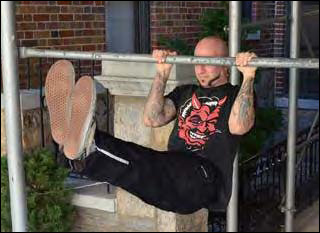
Almost like a bodyweight biceps curl, the headbanger pull-up is also a great core exercise.
The commando pull-up is another great variation to have in your arsenal. A commando pull-up is similar to a mixed grip pull-up, except you use a narrow grip and pull your head to the side of the bar, alternating which side with each rep. If you aren’t strong enough for this yet, you can try a modified version with your feet up on a nearby bar or other object.
It’s good to practice switching the position of your hands on alternating sets with variations like mixed grip and commando pull-ups. For example, if my right hand is closer to my face on the first set, I’ll keep my left hand closer on set number two. For this reason, I typically will do an even number of sets if I’m using these pull-up variations in my regimen.

It’s good to practice switching the position of your hands on alternating sets with variations like mixed grip and commando pull-ups.
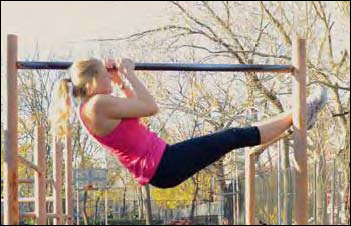
You can try a modified version with your feet up on a nearby bar or other object.
An archer pull-up involves keeping one arm straight while pulling your body towards your opposite hand. The top position resembles that of someone drawing a bow and arrow. When performing the archer pull-up as practice for the one arm pull-up, try to do as much of the work as possible with the arm closer to you. Think of your extended arm simply as a means of giving yourself assistance. Use it as little as possible. Eventually you won’t need it at all. (More on one arm pull-ups in Chapter 8).

Ready. Aim. Fire!

Once you get to the top position of the archer pull-up, you may decide to perform a typewriter. This is another exercise whose name is a literal description of the movement pattern. Just like an old-school typewriter resetting at the end of a line, when you perform this move your chin stays above the bar as you slide your body towards the opposite side. The typewriter demands strong shoulders and a powerful core. It’s harder than it might look!


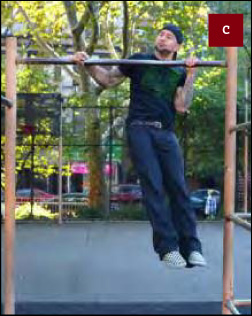
The typewriter demands strong shoulders and a powerful core. It’s harder than it might look!
As the name implies, the X pull-up involves crossing your arms over each other into a letter X formation. This can either be done on one straight bar or two parallel bars. Each version offers their own specific challenges, though the rotational pull of your arms is a factor for either one. You’ll have to go slowly on the way up to keep your body from spinning around. Be careful with your shoulders here, as some flexibility is required to properly perform the X pull-up. You may also be surprised by how much grip and forearm strength is needed to perform this one.
Though it’s a cool looking move and something you may find worth trying, I’ve never seen the X pull-up as an essential variation. For the love of pull-ups, I’m including it here, but the others on this list will likely be more worth your while.

Note the unique grip I’m using for this variation.
Go slowly in order to keep your body from spinning around when performing X pull-ups.
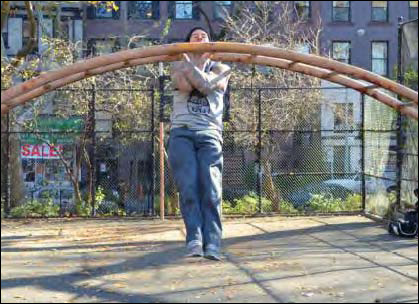
As I mentioned in chapter one, the Australian pull-up is a great technique for beginners to use while building towards full pull-ups, but the Australian is still a worthwhile tool for someone of any strength level. Remember that the Australian pull-up is really more of a row than a pull-up, so it’s worth keeping in your repertoire in some capacity as it’s almost an entirely different exercise.
While a beginner should start with a bar that’s around waist height, when you’ve advanced beyond that you should use a lower bar to decrease your leverage. Eventually you’ll need to put your feet up on a second bar to put your body on a declined angle in order to make this exercise challenging enough. You can also experiment with plyometric Australian pull-ups by explosively switching from an overhand to underhand grip in between reps, or sliding your hands from a wide grip to a narrow grip and back. There is always a way to add a new challenge to a basic exercise.

Remember that the Australian pull-up is really more of a row than a pull-up.
Keeping your legs at a 90 degree angle to your body while performing pull-ups adds a tremendous amount of difficulty. Your abs will have to work very hard to maintain the position as you pull your chin past the bar. Additionally, the balance changes through the range of motion during an L-sit pull-up, forcing you to slow down in order to maintain control.

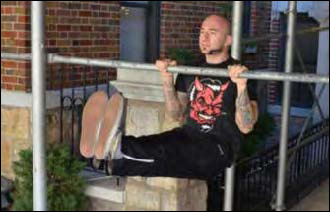
Here we see two different variations on the L-sit pull-up.
In the world of pull-ups, kipping (using the momentum of your hips to generate power) is a highly contested topic. Some say that kipping is cheating, but I think that’s a narrow-minded view. While a kipping pull-up won’t help you build strength as directly as strict form pull-ups, learning to kip can still be a useful skill. Even if you’re already proficient at standard pull-ups, working on your kip can help you on your way towards plyo pull-ups and muscle-ups.
As kipping pull-ups require less upper body strength than standard pull-ups, people might consider kipping to be a beginner technique. Yet here I am writing about it in the advanced pull-ups section. That’s because I think everyone who considers themselves advanced in the world of pull-ups should be able to kip. I’ve seen a lot of people who were strong on pull-ups but struggled with learning the muscle-up because they couldn’t figure out the kip. I was once one of those people myself!
While pull-ups are typically performed by going straight up and down, the kipping pull-up creates an arc, rather than a straight line, as a means to quickly propel the body upward.
To train your kip, start by hanging on the bar with your shoulders pulled down into their sockets. Swing your legs and use your hips to generate momentum. Remember playing on the swings in the playground when you were a little kid?

Swing your hips and push your chest forward to get some momentum.
When you get the feel for this, you will soon be able to generate upward momentum by whipping your body to create an S shape movement pattern on the way up. When your legs are in front of your body at the end of your swing, push your chest forward and let your back arch slightly, this will generate more return force on the way back. Think about what happens to a rubber band when you stretch it out and then let it go. When you kip, you are trying to use your body like a rubber band, so make it snappy!

Kip Kip Hurray!
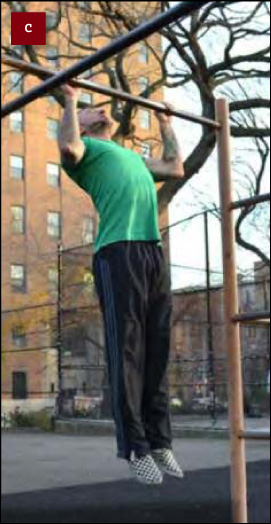
When you get the feel for this, you will soon be able to generate upward momentum by whipping your body to create an S shape movement pattern on the way up.
Once you’ve gotten confident with controlled pull-ups and you’ve learned how to kip, you can put the two together and begin training plyo-pull-ups. Any type of explosive pull-up in which you let go of the bar is a plyo. When you perform plyo pull-ups, think about pulling your chin over the bar as fast and explosively as possible. In fact, don’t think of pulling your chin over the bar - think of pulling the bar below your chest! Once you get the feel for this, try opening your hands for a split second. Eventually you can develop enough power to take your hands off long enough to clap. Maybe even behind your back.

There are lots of other variations on the plyo pull-up. You can switch from an overhand to an underhand grip, slide from a narrow grip to a wide grip, try to touch your toes in mid-air or anything else you can think of. Once you develop the strength, power and confidence to go for harder moves, you can improvise challenging freestyle workouts in just about any setting.

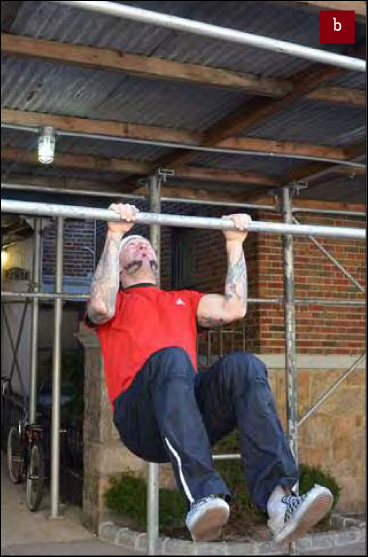
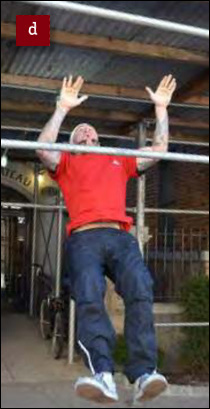
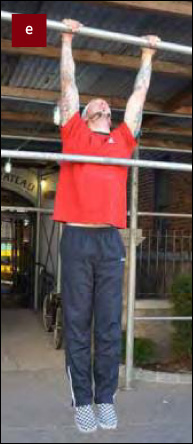
In the world of pull-ups there is plenty of room for personal style and creativity. No matter how many pull-ups you see, you’ll never see them all. Pull-ups are like fingerprints, every individual has a distinctive way of doing their thing on the bar. The endless possibilities of bar training is the beauty of it all.

The endless possibilities of bar training is the beauty of it all.